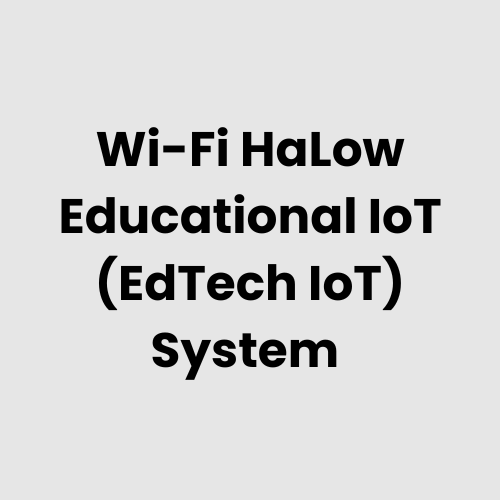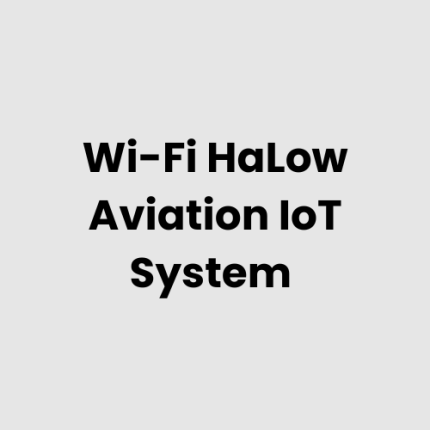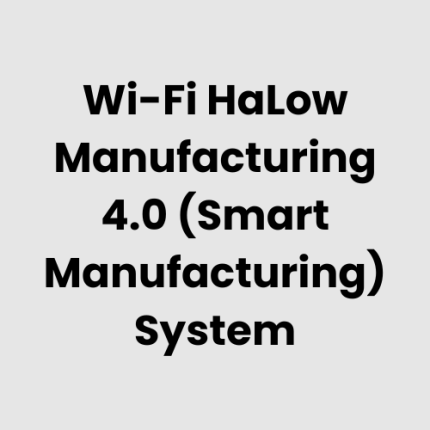Description
Wi-Fi HaLow Enabled Educational IoT (EdTech IoT) System: Technical Architecture
The Wi-Fi HaLow Enabled Educational IoT (EdTech IoT) System uses the long-range, low-power Wi-Fi HaLow protocol (IEEE 802.11ah) to create a connected ecosystem for educational environments. By integrating advanced IoT devices with educational technologies, the system offers enhanced learning experiences, efficient resource management, and real-time data monitoring.
The technical architecture of the system is divided into several key layers to ensure that the solution is scalable, reliable, and efficient:
- Connectivity Layer: The Wi-Fi HaLow protocol serves as the primary communication medium, enabling devices to operate over large campuses or across classroom settings while consuming minimal power. Its long-range capability ensures seamless connectivity in buildings, schools, and university campuses.
- Device and Sensor Layer: This includes various IoT devices like smart whiteboards, interactive projectors, attendance tracking sensors, environmental sensors (e.g., temperature, humidity), and wearable devices for students and staff. These devices collect data to enhance both teaching and learning experiences.
- Edge Computing Layer: Data collected from the devices is processed locally at the edge to reduce latency and enable immediate responses. This is crucial for time-sensitive applications such as student tracking, room monitoring, and energy optimization.
- Data Aggregation Layer: The aggregated data from multiple IoT devices is sent to centralized servers for analysis. This layer enables the creation of dashboards, reports, and analytics that help educators optimize their strategies and resources.
- Application Layer: This layer includes all the educational software and platforms that interact with the IoT data. It may involve applications for classroom management, learning analytics, student progress tracking, and communication tools between teachers, students, and parents.
- Security Layer: Security protocols are embedded in the system to ensure the safety of data and protect against unauthorized access. This includes data encryption, secure device authentication, and compliance with privacy regulations.
Hardware Components of the Wi-Fi HaLow Enabled Educational IoT (EdTech IoT) System
The hardware components of the Wi-Fi HaLow Enabled Educational IoT System are designed to provide seamless, reliable, and low-power connectivity within educational settings. These components include:
- Wi-Fi HaLow Routers and Gateways: These devices enable long-range communication with IoT devices throughout the educational campus, offering high connectivity performance with minimal energy consumption.
- IoT Sensors: These sensors include environmental sensors (temperature, humidity, CO2 levels), motion sensors, attendance tracking devices, and light sensors that monitor the classroom environment and student activity.
- Wearable Devices: Wearables can be used by students and teachers for various purposes, such as health monitoring, attendance tracking, and location-based services in large school campuses.
- Smartboards and Interactive Displays: These interactive teaching aids are connected to the system to allow real-time content sharing, collaboration, and monitoring of student interaction.
- Edge Computing Devices: These devices process data locally within classrooms or campus areas to reduce latency and support quick decision-making, especially in real-time classroom management.
- Control and Monitoring Stations: These centralized devices help educational administrators to manage the system, monitor data in real-time, and configure devices across the campus.
- RFID Tags and Scanners: Used for student and asset tracking, these devices ensure that valuable educational resources and student attendance are monitored efficiently.
- Energy Management Devices: Smart power meters, motion sensors, and other devices optimize the energy usage across the campus, ensuring that facilities operate efficiently.
Physical Placement Considerations of the Hardware
The physical placement of the hardware components plays a key role in ensuring optimal performance and connectivity of the Wi-Fi HaLow Enabled Educational IoT System. Some key considerations include:
- Router and Gateway Placement: Wi-Fi HaLow routers and gateways should be distributed throughout the educational environment, including classrooms, lecture halls, libraries, and administrative offices, to ensure extensive coverage and robust network performance. The long-range capabilities of Wi-Fi HaLow enable devices to be placed further apart than traditional Wi-Fi solutions.
- Sensor Placement: Environmental sensors (temperature, humidity, CO2) should be installed in classrooms, auditoriums, and cafeterias to monitor air quality and overall learning conditions. Motion sensors should be positioned near entrances and exits to track attendance and movement.
- Smartboards and Interactive Displays: These devices should be positioned centrally in classrooms or lecture halls to maximize visibility and interactivity, encouraging student participation.
- Wearable Devices: Wearable devices for students and teachers should be placed where they are easily accessible. These devices may be issued to students at the beginning of classes or sessions and can be used for tracking movement, monitoring health, and enhancing classroom participation.
- Edge Computing Device Placement: Edge devices should be strategically placed in classrooms or common areas, near where critical data is being generated, to facilitate local processing and reduce latency.
- Energy Management Devices: These devices should be deployed across the campus, especially in high-traffic or high-energy areas such as hallways, cafeterias, and sports complexes, to optimize resource management and reduce operational costs.
Hardware Architecture of the Wi-Fi HaLow Enabled Educational IoT (EdTech IoT) System
The hardware architecture integrates various components that work together to enable seamless interaction within the educational environment:
- Communication Backbone: The Wi-Fi HaLow routers and gateways establish the primary communication network, providing reliable and long-range connectivity for all IoT devices, sensors, and wearables across the educational facility.
- IoT Devices: These include environmental sensors, attendance trackers, motion detectors, and asset management devices, which monitor classroom conditions, student activity, and asset usage in real time.
- Edge Devices: Edge devices are used for local processing of data, ensuring immediate action on critical tasks such as attendance taking, classroom environmental adjustments, and health monitoring.
- Centralized Control Stations: These stations are responsible for managing and monitoring the entire IoT network, analyzing data, and making system-wide decisions based on aggregated insights.
- Integration with Educational Platforms: The IoT devices are integrated with educational platforms and learning management systems (LMS) that allow real-time student data collection, performance monitoring, and instructional adjustments.
Deployment Considerations of the Wi-Fi HaLow Enabled Educational IoT (EdTech IoT) System
Successful deployment of the Wi-Fi HaLow Enabled Educational IoT System in educational environments requires careful planning and consideration of various factors:
- Site Survey and Network Planning: A thorough site survey should be conducted to map out the campus and identify the optimal locations for routers, sensors, and interactive devices. This ensures proper coverage and connectivity in classrooms, hallways, auditoriums, and common areas.
- Scalability: The system must be scalable to accommodate future growth, whether in terms of additional IoT devices, more classrooms, or increased student enrollment. The Wi-Fi HaLow network can easily be expanded as needed.
- Integration with Existing Infrastructure: The system should integrate smoothly with existing educational technologies and platforms, such as Learning Management Systems (LMS), student information systems, and administrative tools, for a unified user experience.
- Security and Privacy: Educational institutions must ensure that all IoT devices are secure, with encryption and authentication measures in place. The system should also comply with relevant privacy regulations, such as FERPA (Family Educational Rights and Privacy Act) and GDPR, to protect student and faculty data.
- User Training and Support: GAO Tek offers comprehensive training for educators and administrators, ensuring they can make the most of the IoT system. Our team provides expert support both remotely and on-site to assist with troubleshooting, upgrades, and maintenance.
List of Relevant Industry Standards and Regulations
- IEEE 802.11ah (Wi-Fi HaLow Standard)
- Family Educational Rights and Privacy Act (FERPA)
- General Data Protection Regulation (GDPR)
- ISO 27001 (Information Security Management)
- National Institute of Standards and Technology (NIST) Cybersecurity Framework
- ISO 9001 (Quality Management Systems)
- IEEE 802.1X (Network Access Control)
- International Society for Technology in Education (ISTE) Standards
Local Server Version: Running with a Local Server
For institutions preferring local control over their educational IoT infrastructure, the Wi-Fi HaLow Enabled Educational IoT System can be deployed using local servers:
- Local Data Processing: Data from IoT devices and sensors is processed on-site, allowing for fast responses to classroom needs, such as adjusting temperature or tracking student attendance.
- Data Security: With local servers, educational institutions can maintain full control over their data, ensuring it remains secure within the campus environment and complies with local data privacy laws.
- Offline Functionality: In case of network disruptions, the local server can continue processing and storing data until connection is restored, ensuring continuous operation.
Cloud Integration and Data Management
Cloud integration enhances the capabilities of the Wi-Fi HaLow Enabled Educational IoT System by enabling centralized data management, storage, and analysis:
- Centralized Data Storage: Data collected from IoT devices is securely stored in the cloud, making it accessible for analysis, reporting, and decision-making from any location.
- Analytics and Reporting: Cloud-based analytics platforms allow administrators and educators to gain insights into student behavior, resource utilization, and classroom performance, facilitating better decision-making.
- Integration with Educational Software: The system
GAO Case Studies of Educational IoT (EdTech IoT)
USA Case Studies
- San Jose, California: A school district in San Jose integrated IoT-powered smart attendance systems, streamlining student tracking and reducing administrative workload. GAO Tek provides advanced IoT solutions that enhance operational efficiency in educational institutions. Explore IoT for attendance systems.
- Austin, Texas: An educational campus in Austin implemented IoT-enabled energy monitoring systems, reducing electricity consumption and promoting sustainability. GAO Tek’s IoT technologies support eco-friendly initiatives in education. Learn about energy-saving IoT.
- Chicago, Illinois: A Chicago-based university deployed IoT-based security systems, ensuring real-time monitoring of campus activities and enhancing safety. GAO Tek offers innovative IoT solutions to secure educational facilities. Discover IoT for campus security.
- New York, New York: A New York educational institution utilized IoT technology to monitor classroom air quality, ensuring a healthier learning environment. GAO Tek’s IoT solutions enhance student wellness through precise environmental monitoring. Learn about air quality IoT.
- Raleigh, North Carolina: An institution in Raleigh integrated IoT-driven learning analytics systems, enabling personalized education experiences. GAO Tek helps transform learning with IoT solutions for data-driven education. Explore IoT for learning analytics.
- Boston, Massachusetts: A Boston university implemented IoT-enabled library asset management, ensuring efficient tracking of books and resources. GAO Tek supports educational institutions with robust IoT systems for resource management. Discover IoT for asset tracking.
- Seattle, Washington: A Seattle school district used IoT-powered smart lighting systems, optimizing energy usage and improving student focus. GAO Tek’s IoT solutions deliver cost-effective and productive learning environments. Learn about smart lighting IoT.
- Orlando, Florida: An Orlando educational campus deployed IoT systems to track the utilization of sports facilities, ensuring effective scheduling and management. GAO Tek’s IoT technologies enhance resource allocation in education. Explore IoT for facilities management.
- Phoenix, Arizona: A Phoenix school utilized IoT sensors for predictive maintenance of HVAC systems, ensuring uninterrupted comfort. GAO Tek supports educational facilities with IoT-enabled maintenance solutions. Discover IoT for predictive maintenance.
- Denver, Colorado: A university in Denver adopted IoT-based parking systems to manage on-campus traffic and enhance convenience for students and staff. GAO Tek’s IoT solutions streamline transportation management in educational settings. Learn about IoT for parking systems.
- Los Angeles, California: An educational institute in Los Angeles integrated IoT-driven classroom occupancy sensors to optimize space usage and reduce costs. GAO Tek offers IoT technologies that improve operational efficiency. Explore IoT for space optimization.
- Atlanta, Georgia: A school in Atlanta used IoT-enabled wearable devices to monitor student activity levels, promoting healthier lifestyles. GAO Tek supports educational wellness initiatives through innovative IoT applications. Discover IoT for health monitoring.
- Miami, Florida: A Miami university deployed IoT systems to automate irrigation on campus gardens, conserving water and reducing operational costs. GAO Tek’s IoT technologies foster sustainability in educational settings. Learn about IoT for smart irrigation.
- Houston, Texas: A Houston educational facility implemented IoT-powered smart boards to enhance interactive learning experiences. GAO Tek provides cutting-edge IoT solutions for modern classrooms. Explore IoT for smart boards.
- Detroit, Michigan: A Detroit-based school district used IoT systems to monitor bus fleets in real-time, ensuring timely transportation and safety for students. GAO Tek’s IoT solutions enhance operational efficiency in student transportation. Discover IoT for fleet management.
Canada Case Studies
- Toronto, Ontario: A university in Toronto leveraged IoT-enabled campus-wide energy management systems to reduce greenhouse gas emissions and operational costs. GAO Tek supports Canadian institutions with advanced IoT for sustainability. Explore energy management IoT.
- Vancouver, British Columbia: A Vancouver educational campus implemented IoT-driven real-time monitoring systems for laboratory equipment, improving research efficiency and safety. GAO Tek offers robust IoT solutions tailored to research environments. Discover IoT for lab management.
Navigation menu for Wi-Fi HaLow
- Wi-Fi HaLow Gateways/Routers
- Wi-Fi HaLow End Devices
- Wi-Fi Halow – Cloud, Server, PC & Mobile Systems
- Wi-Fi HaLow Accessories
Navigation Menu for IoT
- LORAWAN
- Wi-Fi HaLow
- Z-WAVE
- BLE & RFID
- NB-IOT
- CELLULAR IOT
- GPS IOT
- IOT SENSORS
- EDGE COMPUTING
- IOT SYSTEMS
Our products are in stock and can be shipped anywhere in the continental U.S. or Canada from our local warehouse. For any further information, please fill out this form or email us.
We are looking for partners. For more information on partnering with GAO, please visit Partner with GAO Tek Inc.It lists various ways to partner with GAO, such as OEM Partnerships, Technology Integration, Distribution and Reselling Opportunities, Presenting at the Leading Event TekSummit, Joint R&D Projects, Training and Consulting Services, Industry-Specific Collaborations, Research and Academic Partnerships.



